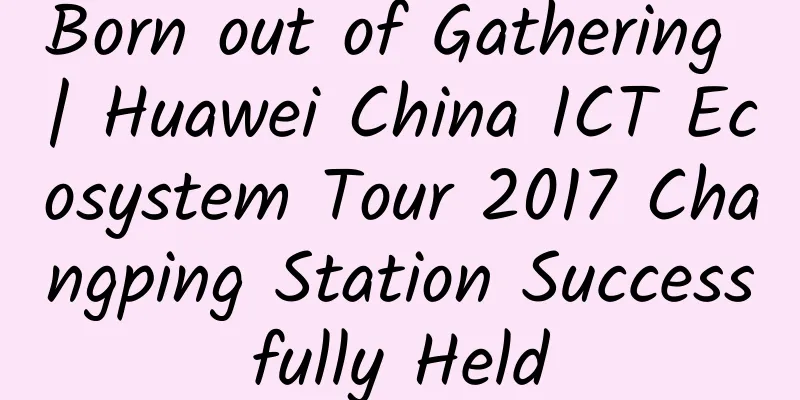Born out of Gathering | Huawei China ICT Ecosystem Tour 2017 Changping Station Successfully Held

|
[51CTO.com original article] On March 24, continuing the theme of "Gathering for Life", the "Huawei China ICT Ecosystem Tour 2017" officially kicked off in Beijing Changping, which lasted for 6 months and covered 300 cities across the country. Huawei hopes to spread the latest ecological construction concepts and policy changes throughout China through the "ICT Ecosystem Tour" series of activities, and build a communication platform for customers and partners to spark the wisdom of digital transformation and jointly explore new business value; at the same time, by bringing leading and open ICT infrastructure platforms to various regions, promoting joint innovation, and ultimately sharing the results of digital transformation with customers and partners. Mr. Wang Hanbing, General Manager of Huawei Enterprise Business Beijing Region, emphasized in his speech: Changping is a new urban development area and new town in Beijing, the capital, and the core area of Zhongguancun National Independent Innovation Demonstration Zone. Huawei has always maintained close cooperation with Changping and Future Science and Technology City. On December 16, 2016, the People's Government of Changping District, Beijing, and Beijing Future Science and Technology City signed a cloud computing strategic cooperation agreement with Huawei. Huawei will deploy a public cloud node in Changping, and will openly develop a variety of solutions and services with customers and partners in various industries in the future to promote the information construction of Changping.
Wang Hanbing, General Manager of Huawei Enterprise Business Beijing Region, delivered a speech Wang Zhigang, Director of the Economic and Information Commission of Changping District, Beijing, emphasized in his speech: In December 2016, the Changping District People's Government and Huawei signed a strategic cooperation agreement to jointly develop cloud computing. The Huawei Cloud Service Data Center project settled in Changping, which is a major achievement in the development of the new generation of information technology industry in Changping District. The district committee and the district government regard this project as a key work of the district. Relying on the policy support of the Changping District People's Government and Huawei's leading technical level and operational capabilities in the field of cloud computing, it brings together upstream and downstream cloud computing companies and focuses on developing key industries such as energy and environmental protection, intelligent manufacturing, biomedicine, and new generation information technology. Mr. Chen Qingcai, Manager of Technology R&D Department of Beijing Future Science and Technology City Technology Development Co., Ltd., also gave a special report to the guests on "Basic Integration Facing the Future - Beijing Future Science and Technology City Joins Hands with Huawei to Build a Smart City", focusing on the current construction of Future Science and Technology City and the many points of convergence with Huawei in the development of smart cities and cloud construction. It is these that make Future Science and Technology City a direct cloud partner of Huawei, and enable Future Science and Technology City and Huawei Cloud to have extensive and in-depth cooperation in the planning of high-end intelligent manufacturing centers, modern service support centers, urban big data application centers, and strategic emerging industry support centers. Share the mission of the times and win the ecological future together As a series of new technologies such as cloud computing, big data, artificial intelligence, and biometrics continue to be integrated into people's production and life, the way human society communicates and organizes is undergoing profound changes. The new generation of ICT technology is undergoing digital reconstruction. Huawei believes that in the digital era, every enterprise must first be a digital enterprise. If informatization is an optimization of the business process of an enterprise, then digital transformation is to redefine the business of the enterprise using ICT technology and conduct a 360-degree digital reconstruction. ICT technology will be transformed from the support system of the enterprise to the production system and decision-making system, and the information department of the enterprise will also be transformed from the cost center of the enterprise to the profit center. Zhou Junxiong, director of Huawei's Beijing Enterprise Business IT Solutions Department, said at the meeting that Huawei is committed to building an open, elastic, flexible and secure platform that is cloud-pipe-end collaborative, and thus helping enterprises build a sustainable ecosystem. Taking the e-government industry as an example, the government cloud is not only a platform, but also an ecosystem. The traditional concept of e-government is "governance" and "digitalization". Each department has built its own information system, forming a chimney-type situation of "no information sharing, difficult business collaboration". The new smart government is people-oriented, and the core concept is "service" and "intelligence". Focusing on the needs of citizens, enterprises, and city managers, cross-departmental information integration is achieved through information technologies such as cloud computing and big data. Zhou Junxiong, Director of IT Solutions Department, Huawei Beijing Enterprise Business The digital transformation of an enterprise involves a series of hardware and software infrastructures, which cannot be accomplished independently by a single enterprise. A good platform can help enterprises shield the underlying complex software and hardware systems, allowing them to focus on optimizing and innovating their own businesses. Huawei is committed to working with partners to build an open hybrid cloud architecture for customers, providing full-stack solutions from hardware, software to services to better match enterprise applications. In 2017, Huawei will release a series of new cloud services and products to help enterprises achieve digital transformation. In the public cloud field, Huawei Cloud will launch more than 50 public cloud services and aggregate more than 500 third-party application services from partners through the application market. In the private cloud field, Huawei will release FusionStage2.0/FusionSphere 6.1 to provide comprehensive support for enterprise innovation. At the same time, in June this year, it will release an open hybrid cloud solution with a unified public cloud/private cloud architecture. Zhou Junxiong also said that Huawei has built various resource platforms for partners, including tangible resources and intangible resources. Huawei has built a world-leading process IT system and created an efficient and convenient channel electronic transaction platform. Through the eChannel system, Huawei completes all cooperation and transactions with partners and opens Huawei's marketing platform to partners to the maximum extent. At the same time, Huawei's brand and corresponding management philosophy will also be continuously opened to partners as an intangible resource platform. Industry Cloud Stimulates Business Innovation In the process of cloudification, public cloud and private cloud will coexist for a long time. Huawei has proposed a hybrid cloud management solution for unified management across clouds and domains. Huawei has built an end-to-end full-site architecture, which includes computer network equipment, corresponding cloud software, and big data software. In addition to building a private cloud system, it has also built a public cloud system. At the same time, it has achieved unified architecture and API in public and private clouds, and can achieve smooth management and smooth migration. This is Huawei's ability in the cloud field. Ou Jun, director of Huawei's Government Cloud Solutions Department in China, introduced Huawei's thoughts from four aspects. The interactive system is the most important area to be designed in the entire enterprise cloudification. In the interactive system, Huawei uses a hybrid cloud approach to place daily access on the private cloud and peak access on the public cloud, and uses Huawei's hybrid cloud architecture solution to achieve unified management and deployment. Insight system. In the field of cloud computing and big data, more companies focus on the BI level, that is, discovering patterns and values from data, but not AI. AI integrates intelligence and self-learning capabilities on the basis of BI. In the process of moving from BI to AI, Huawei can develop different industry algorithms for different industry applications with its partners and customers, and provide them to ISVs and customers for rapid customization. Development and testing system. Huawei not only has outstanding performance in the hardware field, but is also China's largest software provider. In the R&D system, Huawei has invested a large number of elite developers, outsourcing parties and partners to work together for corresponding software development. Software development is carried out on 100,000 desktop clouds for code development, and the operation cloud has built a total of 1.3 million virtual machines to help software development testing and simulation. It is precisely because of such a cloud development and testing system that absolute information security is guaranteed and R&D costs are greatly reduced. In addition, at the end of last year, Huawei launched a development and testing cloud on the public cloud, opening up Huawei's excellent practices in software development accumulated over more than 30 years to partners and customers. Cloudification of technical systems. Cloudification of databases is generally recognized as the most difficult part, especially the transformation of Oracle databases and traditional databases. Huawei has basically solved the problem of database virtualization through bare metal architecture technology. This technology has achieved satisfactory results in the project it cooperated with Lufax some time ago. In addition, Huawei has reached a strategic cooperation with SAP in 2012. In addition to cloudification of SAP and HANA on private clouds this year, it can also use corresponding SAP services through public clouds to achieve unified linkage between public and private clouds. Ou Jun, Director of Huawei China Government Cloud Solutions Department By focusing on the industry and increasing its investment in the industry, Huawei has currently deployed 2 million virtual machines and 420 cloud data centers worldwide. Its customers include finance, government public security, large enterprises, and media resources, and the company is committed to helping corporate customers achieve digital transformation. Wireless IoT technology is one of the basic technologies for building smart cities, realizing Industry 4.0, and China Manufacturing 2025. At the Huawei China ICT Ecosystem Tour 2017 Changping Station, Huawei also brought the eLTE broadband and narrowband integrated wireless IoT solution. Based on the most advanced LTE technology, the solution is committed to building a deeply integrated new ICT wireless network to meet the various business needs of different industries. The network energy solution mainly provides efficient modular UPS, efficient cooling system, and data center management system-DCIM, which can deeply match the construction needs of the new generation of data centers.
Duan Wenzheng, Vice Director of Wireless Solutions Department, Huawei China Aggregate partners to lead the ecosystem Huawei's Beijing Enterprise Business achieved a year-on-year revenue growth of 56% in 2016. There are more than 500 single-product ecosystem partners, including more than 50 gold and silver partners and more than 80 OC partners. Huawei will continue to increase investment in Beijing to help customers from all walks of life promote digital transformation and improve production efficiency; and continue to work with ecosystem partners to build a good ecosystem, grow together, and achieve mutual benefit. Based on in-depth observation and thinking about the digital transformation of the industry, Huawei has proposed a platform + ecosystem development strategy. The platform and the ecosystem are mutually causal and mutually reinforcing. Huawei advocates the use of Leading New ICT technologies and platforms, and the concept of openness, cooperation, and win-win ecology to create a digital transformation community of "customers + partners + Huawei", gather strength, build a prosperous ecosystem, enable customers to achieve commercial success, and enable ecosystem partners to obtain long-term and reasonable returns. [51CTO original article, please indicate the original author and source as 51CTO.com when reprinting on partner sites] |
<<: Android O Developer Preview is finally out! Official introduction of new features
Recommend
SMIC: 2Q20 conference call transcript: Full-year revenue target still grows 15-20%, gross profit margin higher than last year
According to the financial report released by SMI...
Detailed explanation of the working principle of LiveData in advanced Android source code
[[422179]] This article is reprinted from the WeC...
Is listening to music to maintain health reliable? Let's take you into the wonderful "music therapy"
Author: Sun Zhenghai Qiqihar Medical College Scho...
Essential: 126 tools and 15 promotion channels for a complete event planning
"What tools are needed for a complete event?...
Is it that PSA’s French romance is not sexy enough or are Chinese car owners too picky?
When it comes to France, the first impression tha...
Stop! Don't use alcohol to clean the screen. It will cause great damage to the screen.
Many friends have the habit of using alcohol to d...
Mobile Internet Marketing Director Operation and Promotion Planning Case
In recent years, mobile Internet has developed ra...
How to carry out refined operations based on behavioral analysis?
Many people may not know that the meaning of the ...
Why are there so many strong earthquakes in Xinjiang? Will there be strong aftershocks? Expert analysis
According to the official measurement of the Chin...
How much does it cost to create a homestay mini app in Zhengzhou?
How much does it cost to produce a Zhengzhou home...
Is Yinlong's 10 billion yuan new energy project going to fail? Too fast expansion is to blame
Recently, a seizure order issued by the Jiangsu P...
Red Magic Mars phone: the leading gaming device, priced at 3,000 yuan and offering an experience of 8,000 yuan
Nowadays, the mobile gaming and e-sports industry...
Shanshan's "Wallpaper Account Operation Tutorial" seizes the trend of pictures and texts and quickly attracts fans and realizes cash
Course Contents: 01. The first lesson of the oper...
For online operation and promotion, can the hit H5 that goes viral be replicated?
In the past two years, we have seen H5s produced ...
NetQin takes off its safety helmet and builds a strong mobile business
April 10 (Reporter Lin Meibing) NetQin, which cla...









